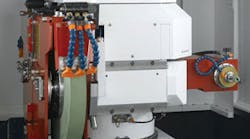Studer’s new S41 CNC universal cylindrical grinder grinds with precision and at extreme metal removal rates, according to United Grinding Technologies. In addition, the longitudinal, cross slide, and swivel axis for the wheelhead feature electric direct drives that move to the working position swiftly and precisely.
United Grinding Technologies is the North American arm of Koerber Schleifring, a grinding technology developer and machine manufacturer. UGT represents the Blohm, EWAG, Jung, Mägerle, Mikrosa, Schaudt, Studer, and Walter grinding lines.
The new machine addresses machinists’ demands for greater precision in their operations, better surface quality on finished products, and higher metal removal rates. UGT explained that the Studer S41 CNC universal cylindrical grinder is based on an earlier design that has been proven effective over many years, with several new design features. It offers a broader range of applications with production options that are highly attractive from any perspective. By saving on auxiliary times, the S41considerably shortens the cycle times of the grinding process, it claims.
Rigid machine bed, maintenance-free guide system
The Granitan® S103 machine bed established a very solid, rigid and thermally stable machine ideal for absorbing the high forces that occur during grinding with high metal removal rates. Its thermal behavior allows the machine to operate with consistently high precision, even with changing ambient temperatures. Its high rigidity and excellent damping are the prerequisites for outstanding surface quality on ground parts and long grinding wheel service life.
The new StuderGuide® guideway system ensures the high precision of the longitudinal and cross slides, while stationary and during movement. The StuderGuide® system uses hydrostatic and hydrodynamic guides and avoids the slip-stick effect or floating of the slide. Also contributing to the machine's high precision is the fact that the solid, cast gray-iron longitudinal and cross slides rest completely on the guideways over the entire travel. “With this maintenance-free guide system, Studer guarantees a straightness of
The longitudinal slide (Z-axis) has a ground worktable that carries the workhead and tailstock as well as additional accessories and devices. Longitudinal and cross slides are moved by linear direct drives and, moving at up to 66 ft per minute, achieve four times higher travel speeds and axis system resolutions of ten nanometers than the previous design. This allows high-precision and highly efficient grinding, helps to reduce auxiliary times.
The swivel movement of the turret wheelhead (B-axis) is powered by a direct drive, too. It swivels the turret wheelhead around three times faster and positions the new grinding wheels in a much shorter time with a positioning resolution of 0.00005 degrees. As such, positioning is said to be twice as precise as with the predecessor machine. The elimination of the Hirth gear, which fixed the wheelhead in position on the predecessor machine, also speeds up positioning.
The S41 also allows shops to cover a wider range of workpiece sizes, and thus more customer groups. This includes greater heights of centers and distances between centers, so workpieces weighing up to 551 lb. can be machined.
Up to four external grinding wheels or three internal grinding spindles enable over 30 grinding head combinations. The grinding wheels are now driven by motor spindles rather than belt drives; the machine can be equipped with motor spindles for high speed grinding (HSG); internal grinding spindles with speeds from 6000 to 120,000 rpm can be used; and automatic balancing systems and frequency converters for each external grinding spindle allow grinding processes to be matched to the respective conditions of use. Wheelhead variants are also available with a vertical spindle for grinding keyways or with a traverse grinding axis for traverse grinding of internal tapers.
Simple operation, complete manufacturing processes
The new grinder was designed with a high priority for ergonomics, for fatigue-free working and intuitive machine operation. Hoses and cables have been eliminated as much as possible from the work area of the machine. Grinding wheel changes are performed with a single Allen wrench, and a special small crane is integrated into the machine so that heavier grinding wheels can be installed easily.
Fanuc 31i-A machine controls with integrated PC operate with the specially developed StuderGRIND software for grinding processes, and the StuderWIN operator interface. A 15-in. touchscreen and ergonomically arranged controls are available and an additional manual control unit simplifies grinding setup of the grinding processes. A free-standing operating panel with adjustable height is also available.
In a nod to process optimization, the S41 includes an integrated quality control system based on continuous measurement, re-measurement, recording, and correction. In addition, workpiece grinding with modular peripherals (e.g., loading/unloading systems) can be integrated seamlessly into the complete production process. Automation for the peripheral equipment communicates with the S41 via standard interfaces, so even complex handling tasks are possible.









